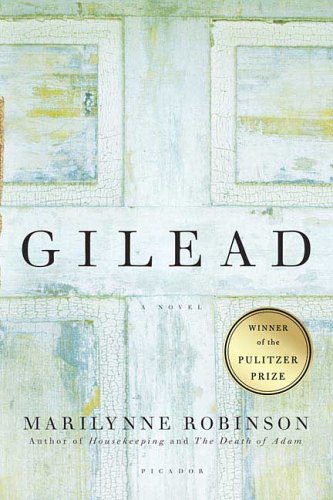
GILEAD
Told through the eyes of a Midwestern minister nearing the end of his life, Gilead unfolds in the form of a letter. As Reverend Ames writes to his young son, we learn of the family’s legacy, a heritage steeped in abolition, economic hardship, and conflicting views on religion and war as each generation comes of age. The 1950s find John Ames comparing his grandfather, a fiery Union Army chaplain, to his devoutly pacifist father while a gentle turn of events poses the question of racial equality in new terms. Throughout the novel, he recalls a life shaped by love—for his faith,
Told through the eyes of a Midwestern minister nearing the end of his life, Gilead unfolds in the form of a letter. As Reverend Ames writes to his young son, we learn of the family’s legacy, a heritage steeped in abolition, economic hardship, and conflicting views on religion and war as each generation comes of age. The 1950s find John Ames comparing his grandfather, a fiery Union Army chaplain, to his devoutly pacifist father while a gentle turn of events poses the question of racial equality in new terms. Throughout the novel, he recalls a life shaped by love—for his faith, his vocation and his church, for prayer, for his town and all it has meant, for his father and grandfather, for his books, for baseball, for his lifelong friends, for his physical life and the splendors of the physical world, for his memories, and for the young wife and infant child to whom he remains loyal over solitary decades.
- Picador USA
- Paperback
- January 2006
- 256 Pages
- 9780312424404
About Marilynne Robinson
Marilynne Robinson is the author of Housekeeping, winner of the PEN/Hemingway Award for First Fiction, and released as a major motion picture in 1987. She has also written two nonfiction books: Mother Country, an examination of Great Britain’s role in environmental pollution, and The Death of Adam, a collection of essays on religion, history, and the state of society. She has an undergraduate degree from Brown University and a Ph.D. in English literature from the University of Washington. She teaches at the University of Iowa Writers’ Workshop.
Praise
“Gilead is a beautiful work—demanding, grave and lucid. . . . Gradually, Robinson’s novel teaches us how to read it, suggests how we might slow down to walk at its own processional pace, and how we might learn to coddle its many fine details.” —James Wood, The New York Times Book Review
Discussion Questions
What was your perception of the narrator in the opening paragraphs? In what ways did your understanding of him change throughout the novel? Did John’s own perception of his life seem to evolve as well?
Biblical references to Gilead (a region near the Jordan River) describe its plants as having healing properties. The African-American spiritual, “There Is a Balm in Gilead,” equates Jesus with this balm. According to some sources, the Hebrew origin of the word simply means “rocky area.” Do these facts make Gilead an ironic or symbolically accurate title for the novel?
The vision experienced by John’s grandfather is a reminder that the Christ he loves identifies utterly with the oppressed and afflicted whom he must therefore help to free. What guides John in discerning his own mission?
How does John feel about his brother’s atheism in retrospect? What accounts for Edward’s departure from the church? What enabled John to retain his faith?
The rituals of communion and baptism provide many significant images throughout the novel. What varied meanings do John and his parishioners ascribe to them?
What answers would you have given to the questions John faces regarding the fate of souls and the nature of pain in the world?
Marilynne Robinson included several quotations from Scripture and hymns; John expresses particular admiration for Isaac Watts, an eighteenth-century English minister whose hymns were widely adopted by various Protestant denominations. Are certain texts divinely inspired? What is the role of metaphor in communicating about spiritual matters?
Discuss the literary devices used in this novel, such as its epistolary format, John’s finely honed voice, and the absence of conventional chapter breaks (save for a long pause before Jack’s marriage is revealed). How would you characterize Gilead’s narrative structure?
Is there a difference between the ways religion manifests itself in small towns versus urban locales? Did the history of Iowa’s rural communities and the strain of radicalism in Midwestern history surprise you?
